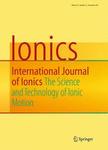版权所有:内蒙古大学图书馆 技术提供:维普资讯• 智图
内蒙古自治区呼和浩特市赛罕区大学西街235号 邮编: 010021

作者机构:Univ Shanghai Sci & Technol Sch Energy & Power Engn Shanghai Key Lab Multiphase Flow & Heat Transfer Jun Gong Rd 516 Shanghai 200093 Peoples R China
出 版 物:《IONICS》 (离子)
年 卷 期:2020年第26卷第3期
页 面:1515-1524页
核心收录:
学科分类:07[理学] 0703[理学-化学] 0702[理学-物理学]
基 金:Capacity Building Plan for some Non-military Universities and Colleges of Shanghai Scientific Committee, (18060502600) National Natural Science Foundation of China, NSFC, (11404210) National Natural Science Foundation of China, NSFC
主 题:Ions Organic compounds Catalysis Degradation Recycling
摘 要:The degradation of nitro and azo compounds has attracted wide attention due to their high toxicity and stability in water. Here, we reported the fast degradation of nitro and azo compounds by the direct injection of high-concentration noble-metal ions (Au3+, Ag+, Pd2+, or Pt4+) and discussed the degradation mechanism. The rate constants of the nitro and azo compounds degradation followed the order: K4-NP K2-NP K3-NP K2-NR K-MR K-MO, explained by the substituent effect. The maximum of the degradation rate constant could reach up to 16 min(-1), which can be attributed to the atom-nano catalysis motivated by the direct injection of high-concentration ions. Furthermore, based on the method, the highlighted conflicts shown in the nitro and azo compounds degradation could be resolved. Meanwhile, the recovery method (centrifugation, dissolution, and purification) of noble-metal ions was proposed by means of various characterization techniques, and then noble-metal ions were recovered and recycled for five cycles. Obviously, the above degradation technology can have great potential for applications in water pollutant removal and environmental remediation.